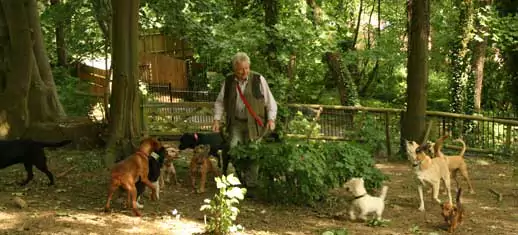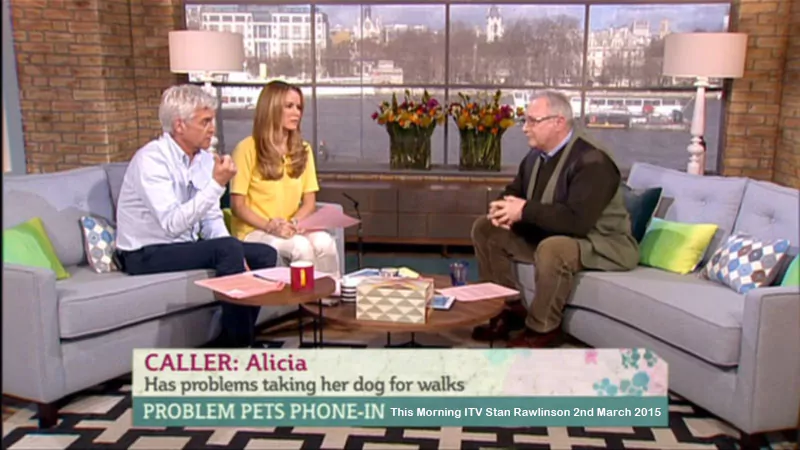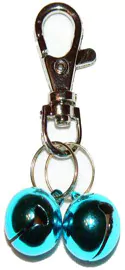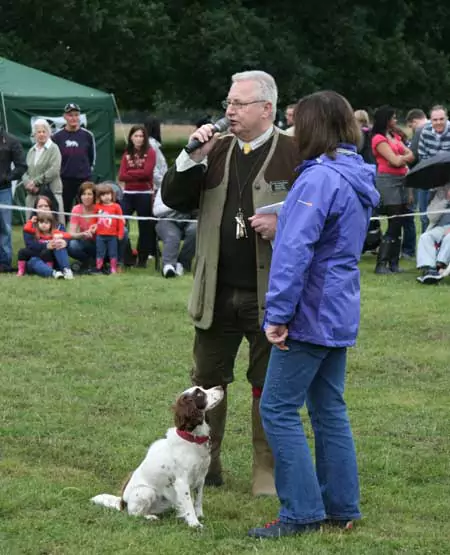My Approach To Dog Behaviour & Training
Everything you need to know about dealing with canine behaviour and dog training from Stan Rawlinson aka Doglistener UKs premier Dog Trainer and Behaviourist. Dog Training The Gentle Way
Train the Owner and the Dog Will Follow

My Methods:
I do not advocate the use of force, coercion, check or choke chains, Haiti’s or any aids that may hurt or injure a dog.
I use positive reinforcement, sound therapy, and the Jingler. I never use a check, choke or prong collars they are never needed.
My Alpha Myth beliefs and techniques are non-aggressive,.I have a unique approach which is both gentle and extremely effective.
Behavioural and Obedience:
I believe it is vitally important that I point out that I have nothing whatsoever to do with Jan Fennel or any other Dog Listener organisations you may have heard of.
I am not, and never have been, part of any franchise that involves the licencing of other trainers or behaviourists to be called dog listeners.I own the Ltd company “Doglistener”
I am the Original Doglistener and have used that name well before the book “The Dog Listener” was even conceived. I have been working with dogs now since 1974. forty years. The last 15 years as a full-time professional Dog Behaviourist
Rank Reduction Programs:
I would never affiliate, or put my name to any individual or organisation that uses rank reduction for every case they deal with.I do not believe these techniques work, especially over the long term. The proponents of these schemes are either deluded or totally ignorant of how pack mentality works. There is no Alpha, a Wolf or Wild Dog pack is based upon a family unit. Father Mother and offspring. It is that simple. They claim that 100% of all problems are pack orientated. “If only it were that easy”.
The picture below shows me taking calls from viewers on their animals behaviour in March 2015
The ITV This Morning Show With Presenters Phillip Schofield and Amanda Holden

What It Requires To Become A Behaviourist:
I believe it takes a minimum of seven years to become reasonably experienced and professional as a dog behavioural and training expert. I believe no one should be called a behaviourist until they have treated on a one to one basis a minimum of 2000 dogs with training and behavioural problems. The idea that you can go through a foundation and advanced course in just days rather than years is just nonsense.

Some of these organisations take people who have never worked with dogs and in some cases not even owned one. They put them through a short course and let them out on the unsuspecting general public. I often have to follow in after these so called “behaviourists”. Then have to work twice as hard to undo the problems these amateurs create
I have written an article called the Alpha Myth which effectively debunks the rank reduction process. This explains how you can actually get real results over the long term. I have many thousands of clients who can attest to that fact.
The Types of Behaviour I Deal With:
I deal with all forms of behavioural and obedience. However, I am an acknowledged expert in cases of aggression, both inter-dog and against humans. Many of these problems are fear based.
I cover timidity, barking, fighting, chewing, personality disorders, separation anxiety, biting, nipping, jumping up, toileting, pulling on the lead, recall. OCD, bowl and resource guarding.
I am also acknowledged as an expert on canine communication, and the rearing and development stages of puppies, including the critical periods for puppies and young dogs.
I assess dogs for type and temperament as an expert witness in cases of criminal prosecution under the Dangerous Dogs Act of 1991. I have an excellent reputation in defending the actions of dogs that find themselves on the wrong side of the law.
I also assess dogs for fostering agencies to make sure the children that are fostered are not in danger from the family dogs.
Working With Specialist Dogs:
I have been working with the handlers and their dogs that are trained to sniff out explosives at Heathrow Airport. An interesting and rewarding job.I was tasked with improving the way they work and to make sure they were achieving the expectations of all concerned, plus creating an environment that the dogs enjoy.
Dog Training Aids:
Besides being in the Army for 10 years I also trained as a professional musician both orchestral and rock ” Oboe and Keyboards” This gave me what is known as relative pitch, which allows me to clearly hear sounds and tones.
I found some 11 years ago, that certain sounds aided training in most dogs. It can intensify your pets ability to concentrate on what you are training your dog to do or what behaviour you are altering. It’s a bit like taking all the adverts out of a programme you are watching, this helps continuity the dog, therefore, learns quicker and with more confidence.

This led me to design and develop the “Jingler” Many trainer and behaviourists as well as many thousands of my clients are now starting to use my “Jingler” methods for many behavioural problems.
These include jumping up, pulling on the lead, aggression, both inter-dog, human, aggression, predatory chasing and much more. for further details click the jingler picture
The beauty of this technique, unlike devices like the Halti or chest harness, my method actually teaches the dog not to pull. As long as you are not near a road you can walk your dog off the lead and he should still stay with you.
Imagine that the jingler is the opposite of a clicker. Whilst the clicker tells your dog when it has done something right, The Jingler indicates when it has done something wrong
There is only one aid to walking to heel I would ever recommend other than the Jingler technique, that is the Canny Collar, it is way above any of the others in quality and use.
Operant Conditioning:
I am a strong advocate of operant conditioning though I generally do not use clickers. Not because they do not work, they do, and very effectively.
The problem is that most dog owners are not professional trainers, they tend to struggle with the technique. You have a lead, a treat, and now you add in a clicker. You have already run out of hands, and then you have to get the timing just right, clicking and treating in one smooth action at the exact time to create the right effect. And who has a clicker when you need one?
You change your clothes and they are in the other pockets. They often get lost or misplaced. It is common that after about three weeks most people give up and put them in the top draw. Which is such a shame as they really do work. I still use these techniques but instead of a clicker I use a target word. You can’t put your mouth in the top draw and you will not need any extra hands. Your timing is related to your mouth which in these circumstances is far easier than using clickers.
Clickers are there to mark good work and to shape behaviour and training. The Jingler to some extent is the opposite, It marks bad behaviour and tells the dog when it has done something wrong. You cannot ignore bad behaviour, it will not miraculously go away if you just praise the good behaviour, and ignore the bad.
Unfortunately, there are lots of trainers out there who state they ONLY ever use positive reinforcement. Then proceed to put a dog on its lead. I point out that this is negative punishment in the operant conditioning spectrum. Negative Punishment is taking away something the dog enjoys and likes. In this case the freedom to run around and enjoy itself. The lead totally inhibits this action. See Killing With Kindness.
Where and How I Work:
I always start my session initially at your own home, this is where most behavioural and training problems initially occur. I cannot understand why trainers or behaviourist’s hold clinics in veterinary surgeries or their office. Dogs act very differently when outside their own environment which often subdues their natural inclinations, masking the very behaviour I need to observe to treat your dog successfully.
Are you aware that the people that say they are “Clinical Behaviourists” are nothing more than behaviourists that see your dog in a clinic? I believe they may be falsely trying to impart that they are someone with clinical knowledge unless they are fully trained veterinarians that would be incorrect.
Residential Training:
I am intrinsically against residential training. I believe it is open to abuse and I have seen and heard of cases of abuse whilst the dogs are in some of these establishments. The problems with residential training is it does not work at the level that is required to change behavioural problems.
Most aberrant behaviour is about owner/dog relationships. Not pack or Alpha behaviour, owners reinforcing, (often by accident) bad behaviour or even causing fear, timidity and aggression by rewarding certain actions. Therefore, how could a residential course possibly sort these problems out?
We are all aware that most behavioural problems are owner/dog/home/related, household dynamics plays an important role in shaping your pets needs. It is in the home that the behavioural problems should be initially seen and where treatment should begin Not some remote boot-camp where we cannot see what they are doing to our dogs. Or in a clinic.
Types of Trainers:
Many of these trainers are ex-military or police and often work on the premise that your dog will do as it is told or else. That is not good enough in today’s enlightened times. Positive reinforcement, operant conditioning and praise are far more successful and less stressful for our much-loved pets. I am an advocate of positive reinforcement.
However I also believe that our pets should understand boundaries, what is acceptable and what is not. I am certainly not one of the trainers that do not believe in correcting bad behaviour.
I still hear the old adage, “no bad dogs only bad owners” that is absolute nonsense. I see bad dogs with good owners, and good dogs with bad owners. Having said that, a large percentage of my cases are caused by the inability of the owner to communicate effectively,with their dogs.
Humans, as well as dogs, need boundaries, guidelines and parameters. They need to know right from wrong. Just ignoring bad behaviour and praising the good, is not logical, practical or successful.
I tend to work on a 75 to 25 ratio. Training the humans 75% of the time and the dogs the other 25%. Guess which is the most difficult animal on earth to train? Let me give you a clue if you were to pick the dog you would be wrong .
.I see myself as the bridge which will allow you to communicate and co-exist happily with your pet. Train and work with the owner and the dog will follow.
Do I Offer Classes?:
Other than puppy classes, all my behavioural and obedience problems are conducted on an individual one to one basis, normally at your own home or in the area they occur, such as the park or road etc. My charges are by the session not the hour. So no need to clock watch. The majority of my cases only require ONE visit.

The basic requirements for a happy and contented dog, sit, stay, heel, recall, walking to heel and general basic training helps your dog know its place in the family pack system.
It stimulates your dog’s mental processes which often helps other behavioural problems, such as frustration, lack of confidence, and the inability to communicate effectively between dog and owner.
Puppy Assessments:
Preferably as young as possible. This is a full personality assessment at your own home. It includes an appraisal test to indicate your dog’s character, dominance, and possible aggression in later life, it also indicates your puppies ability to learn and points to the methods that work best for your individual puppy.
This allows you to tailor your training to your dog’s individual temperament, aptitude and ability. This is extremely important area and should be considered for all new dogs but especially first-time dog owners.
The assessment also covers sleeping arrangements, biting and mouthing, jumping up, feeding, toileting, initial training schedules, training expectations crate training and important articles including Critical Periods in a Puppies Psychological Growth an excellent pointer to what you can expect in your pup’s first 14 months,
My easy to understand program showing the do’s and do not’s of dog ownership is insightful. Plus The Art of Communication which explains how to communicate effectively with your pet, what commands to give, when to praise and more importantly when not to.
You also get a checklist for socialising your puppy Puppy Socialisation Chart and my articles on first aid for pets and teaching basic obedience. These articles plus the assessment and checklists will give you and your dog a solid and structured format to work with, and will put you well on the road to a happy and harmonious relationships…
Puppy Classes:
For pups under 18 weeks of age at the start of the 6-week sessions. Puppy socialisation classes are the bedrock for a happy and contented adult dog.
Pups learn more between 0 and 16 weeks than the remainder of their lives times ten. Training and socialisation at this time will be the most beneficial they ever receive. Gone are the days when we did not start training until 6 months. It was that belief along with not setting rules and boundaries that got dogs rehomed and euthanised.
Early training and puppy socialisation will impress on your puppy that it should not be aggressive, forceful or a bully, it helps to teach manners towards other dogs and people. It gets them used to being handled and approached by strangers and children and to meet, greet and play with other dogs in a controlled manner. I have a maximum of 10/12 per class.
These are held on Monday evenings at 6.30 Methodist church hall in Hampton. You will need to book in advance as my classes are extremely popular and normally fill up very quickly. If the weather is warm we have the classes outside. click HERE to see next available class plus costs.
Recall:
This is often an area I am asked to look at and cure. This often stems from early learning during the crucial period between 7 and 16 weeks ,therefore, my puppy assessments cover this. However if you are already experiencing recall problems then I usually conduct these in Bushey Park or a Park of your choice.Type in recall training into Google and I am first in the World,
Pulling on the Lead:
Probably one of the most common problems I am asked to deal with. I have a unique technique that will stop your dog pulling almost immediately without the use of gimmicks like Haiti’s, harnesses, and other aids which do not train your dog not to pull only restricts the dog. My method actually teaches the dog to heel correctly both on and off the lead. Type in recall training into Google and am once again first .
See also MY SERVICES & CHARGES which breaks down all the services I offer.
Dear Mr Stan Rawlinson
I have never had the need to use your services and have trained and kept dogs for the past 30 odd years but I have just found your website and read every word of it. I just had to contact you to say a big thank you for your approach to training dogs. Without knowing your methods I appear to have replicated them to some extent and have had some fantastic companions in dogs. You are an inspiration to trainers and I look forward to reading more about your approach.
WELL DONE AND THANK YOU
Jess Ongley (Mr)
.








